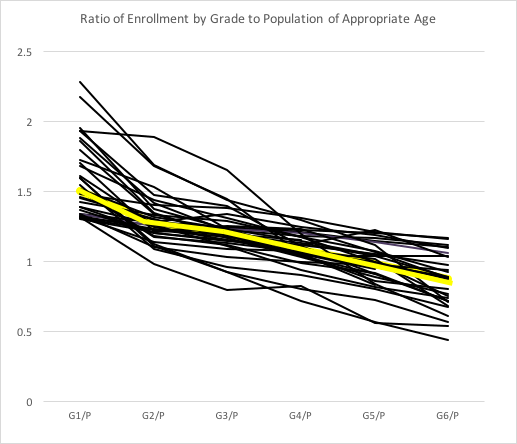Luis Crouch
RTI International (Emeritus)
Blog
There is a set of countries where we would argue there is a real crisis in the foundation years of the education system. This crisis is determinant of very low learning levels and primary school completion rates. This is a set of countries that have moved up from absolutely minimal access, and that receive and have received a lot of development agency support, but have not yet progressed as much as the typical RISE countries (e.g., Vietnam, Tanzania). The set includes countries such as Rwanda, Timor-Leste, Malawi, Burundi, and some thirty-five others. About forty percent are countries in the Global Partnership for Education, a global fund dedicated to education in developing countries. These countries receive support from the World Bank, the UK’s Department for International Development (DFID), or the U.S. Agency for International Development (USAID) and have expanded schooling access vastly in the last ten to twenty years.
However, there appears to be a massive problem of weak foundation years. This shows up in very skewed patterns of enrolment, whereby enrolment in Grade 1 is, on average, fifty percent higher than is required for the population of the appropriate age.
The graphic below shows the problem. It presents the ratio of enrollment to population for the first six grades of schooling systems, chosen so that the ratio of enrollment in Grade 1 to the population of appropriate age is 1.3 or higher. That is, showing over-enrolment of thirty percent or more.

Source: Calculated from the UNESCO Institute for Statistics data via the World Bank
The children within the bulge of the early grades are not there because the system is playing “catch-up” by enrolling older, never-enrolled children. The accompanying "INSIGHT" substantiates this argument. The short version of the argument is that many of these countries have had this kind of bulge for at least a decade, sometimes two. With an over-enrolment bulge of thirty percent (that is, excess intake of thirty percent of a cohort), then if the problem is that the system is catering to older, never-enrolled children, then a deficit in enrolment of thirty percent would have been absorbed in approximately seven years, assuming that children past the age of fourteen or fifteen are unlikely to join the system in great numbers. The basic point here is that a child cannot be “newly enrolled” in the system more than once.
Thus, most of these children are repeaters of some kind or another - children whom the system has no problem re-enrolling in the same grade, whether they officially failed or not. Since many education systems forbid repetition and engage in automatic promotion, the true extent of repetition is not reported. Even in countries where repetition is allowed, the system frowns upon it. However, parents and teachers often make children repeat if they have not learned much. In fact, children are sometimes simply not expected to learn much the first time they go through a grade in the early years. In some cases, children arrive at Grade 1 with almost no preparation (often perhaps not having held a book, not having been read to), and are presented with a curriculum that has an urban, middle-class bias. In some countries, large numbers seem to repeat at least the first two grades. This represents a fairly extreme version of the lack of “Teaching at the Right Level.”
The graphic above also shows that the problem is not just in Grade 1, but occurs in the first three grades: children churn for perhaps four to five years to accomplish three grades of schooling and then eventually drop out. Other research I have carried out suggests that these problems in the foundation years (over-enrolment, lack of preparation, etc.), taken together as a syndrome, explain about thirty-four percent of the variation in primary school completion rates, whereas spending per child explains only about nine percent of that variation. In these countries, the foundation year problems create a quality log-jam right at the beginning, from which it is either impossible or very expensive to recover.
While only one of the six countries in the RISE Programme (Ethiopia) suffers from this syndrome to any great extent, the countries that would presumably eventually benefit from the RISE research suffer from the syndrome. Applying lessons of systemic improvement, derived from the RISE Programme, and in particular from efforts to “Teach at the Right Level” (both in a curricular sense, and in the sense of aiming improved teaching at the base of the system) would hold out great hope for improvement in these countries.
RISE blog posts and podcasts reflect the views of the authors and do not necessarily represent the views of the organisation or our funders.